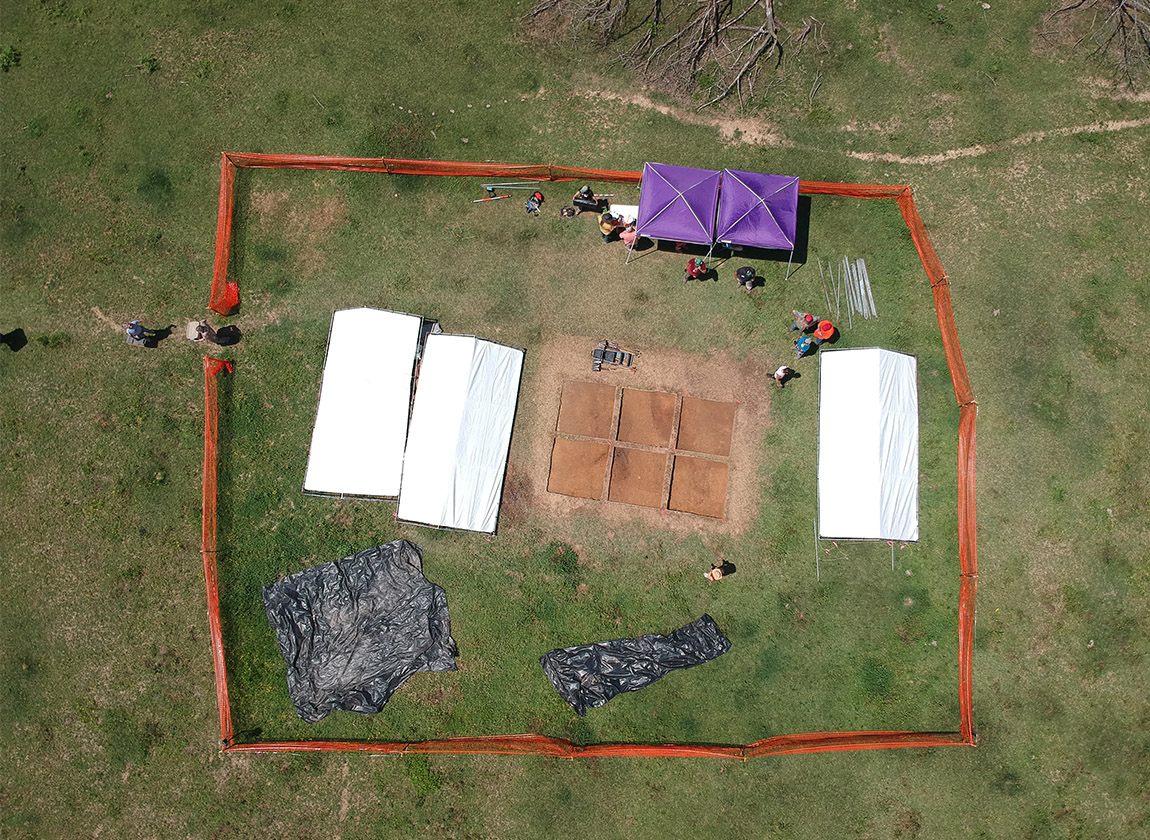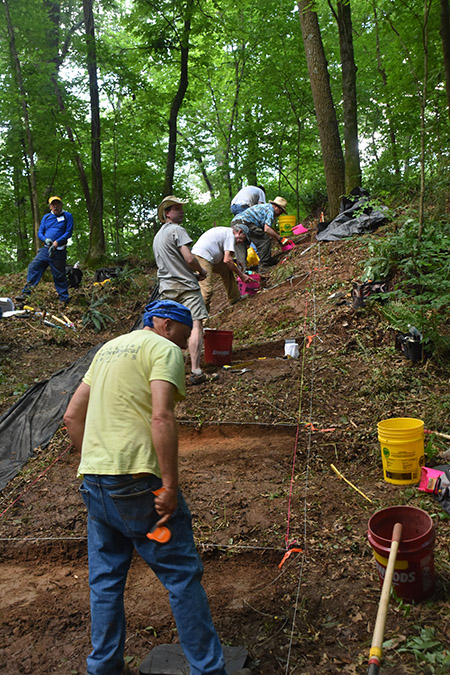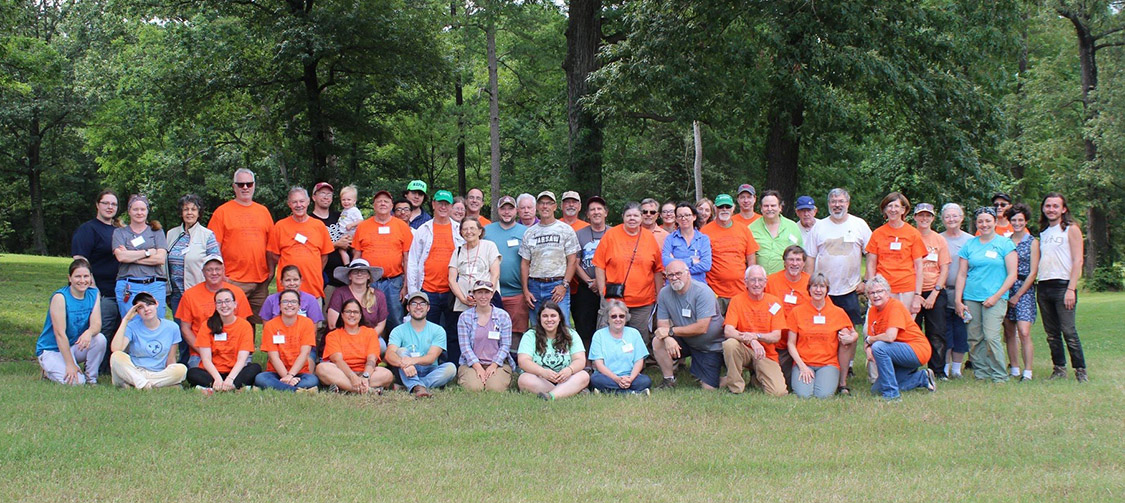
By Carl Drexler
ARAS station archeologist at Southern Arkansas University
Every year, the Arkansas Archeological Society gathers in some part of the state to hold its annual Training Program. This June, we met in Sevier County, in the western edge of the state, studying two sites, Holman Springs and Lockesburg Mounds, as part of a larger research project of the Arkansas Archeological Survey’s research station at SAU.
What is the Training Program?
The Society is a group of people who are “avocational archeologists,” or people who love archeology and want to do it well, but do other things to make a living. The Survey and Society work together on the Training Program; Society members bring their enthusiasm and curiosity while Survey staff bring their expertise to provide instruction. For two weeks, we have some people working and learning in the field, others in the lab, and more taking classes in anything from mapping sites to paleoethnobotany (how people used plants in the past). We had sixty people sign up for this year’s program, coming from all across Arkansas as well as Texas, Louisiana, Illinois, and even Pennsylvania to participate. Sound cool? Sign up for the Society and join us next year!
The Sites

For this year, we did research on two sites. I should point out that we talk about these sites as places that have a life unto themselves, and think of them as telling us certain things about the past. But it is important to remember that what we are really studying are the people who made these sites, and that the artifacts and features we recover are a bridge to the people who lived there and left their traces behind in these sites.
Okay, back to the main story. Both of these places are in one of the least-studied archeological regions in the state, so any headway made by the Training Program is a big addition to what we know about Arkansas’s past. So what are these two places? Holman Springs is the name we give to a place where Caddo Indians came between the 1300s and 1500s to make salt. They chose that place because it is next to a salt spring. They collected the brine and reduced it to salt crystals that they could then trade to their neighbors.
The other place we refer to as Lockesburg Mounds, because it’s near Lockesburg. The Caddos built the site, probably about the same time they were making salt at Holman Springs. It was a very different place, though. The Caddos did not live in large villages like other Southeastern Indians at the time. They instead lived in small farming hamlets scattered about the landscape, tending crops. Amid these farming settlements they would build large ceremonial mound centers where they would congregate to hold festivals to mark certain times of the year and different stages of life. Lockesburg Mounds was one of these major mound centers.
Why These Two Sites, and Why Now?
We didn’t just pick these two sites because they were there, and we needed something to do. Both places are important to do research on now to better understand Caddo, Arkansas, and American history, and to fix some problems. What problems? Well, let’s start with Holman Springs.
This is not the first time we did research at Holman Springs. The Training Program was held there before in 1985 and 1986, but the artifacts from those years were never analyzed (long story for another time). There were hundreds of boxes of saltmaking pottery fragments recovered during those programs in the 1980s, and they needed to be studied. This would tell us a lot about Caddo life, food, and economics. It also is the ethical thing for archeologists to do—finish what you start! Not having it done was a problem.
Lockesburg Mounds has a different problem. Archeologists had never dug on it before this summer. But others did. Local relic hunters dug into it repeatedly, looking for artifacts to sell. They have damaged all of the mounds on the site, some quite badly, and we lost a lot of information about the past as a result. That was our other problem. Research and careful, methodical excavation help us fix that problem.
What Did We Do?
With Holman Springs, our big task was to deal with the artifacts already excavated. There were hundreds and hundreds of boxes to go through, and our office (2 people) could not do that in less than a decade. So to finish the Society’s project from the 1980s, we got the Society to join in the analysis. Dr. Mary Beth Trubitt, from our station at Henderson State University and a specialist in Caddo archeology (particularly ceramics), taught a class on how to analyze Caddo pottery. Her students worked through a huge number of the Holman Springs artifacts. By the end of the two weeks, they had done almost 100,000 pieces! That’s awesome! It also means that completing the Holman Springs research from the 1980s is actually doable.
With Lockesburg Mounds, we had another job entirely. We were not completing research, we were starting it. So how do we approach a giant site that has been so heavily damaged? Well, for starters, we realized that we were not going to be able to do everything that needed to be done at the site to get all of the answers to questions we might have about it. There’s simply too much we don’t know. Accepting that, we decided to take on two pieces of work.

First, we wanted to get a look inside the big platform mound at the site, known as Mound A. (A platform mound is an earthen pyramid-shaped mound with a flat top, often supporting a special-purpose building of some kind.) This was probably the central place within the site, and it is also one of the most heavily damaged. So we selected one of the old looter holes, a big trench, and laid out a line of 2m squares going down it from mound top to base. Over the two weeks we were out there, we dug these units down through the damage, creating a profile wall that just edged out of the cut. This showed us the stratigraphy within the mound as well as the damage done to it.
Ask anyone who was out there and they will tell you that digging on the steep side of a mound is difficult, slippery work. We did not want to have everyone who was signed up for the dig out on the big mound. It would be dangerous to them and to the mound. We decided to place a second dig area in the adjoining field, on a small mound we call Mound E. This mound was on earlier maps of the site, and was still visible on the surface despite years of agricultural work on the area.
We set up our Basic Excavation class at Mound E. This group worked over two weeks to expose as much of the subsurface as possible. They found some really interesting things. First, we think they found the top of a hearth, the central fire in what would have been a large house. Second, they got a nice big burned timber from the site, which will allow us to run a carbon-14 sample to give us a direct date on the structure. Finally, when we got a good look at the completed (for now) excavations, we saw pretty clearly that the house had two big backhoe bites going right through it. Again, we were able to see the damage caused by looters as well as the intact material around it.
What Did We Find (Out)?
Some good things came out of our summer’s work. First, we got a good look at the Holman Springs ceramics. It’s mostly shell-tempered salt-making pottery, suggesting a heavy emphasis on a 1500s occupation of the site.
Second, at Lockesburg Mounds, we saw two major construction levels in the big platform mound, and we could even see patterns in the dirt made by Caddos dropping single basket loads of soil as they built the mound. At Mound E, it looks like we have a house in the middle of that mound, but it has been heavily damaged by relic hunters.
There is a lot more to do to wind up this summer’s work. We have a lot of laboratory time with the artifacts from Lockesburg Mounds ahead of us (which is a fun and cool thing). We also have to sit down with the data sheets from Holman Springs and see if there are patterns in the data suggesting different parts of the site were used at different times. The invaluable work by the Society this summer makes that possible. There are carbon-14 dates to run, geophysical data to consider, and future excavations to plan. It’s going to be fascinating!
One Last Word
As it should be clear by now, we at the SAU Station of the Survey did not do this project alone. Obviously, this was a collaboration with the Arkansas Archeological Society, and we cannot thank them enough for partnering with us; we really enjoyed working with them on their Training Program. Marilyn Knapp, our liaison with the Society, did a huge amount of work making this go smoothly. There are other people who put a lot of time and effort into this, and we should acknowledge them too. We would like to thank Larry and Greg Hale for granting us access to the site. Matt Smith was a big help and did not raise an eyebrow with all of these folks being around his cows. Big thanks go to Chancellor Steve Cole and Tommi Cobb at UA-Cossatot for setting us up with lab space and serving us a lunch in the field. Finally, we would like to thank Chairman Tamara Francis and the Caddo Nation of Oklahoma for helping us plan this work and providing comment and feedback in the months leading up to the project.
Related:

